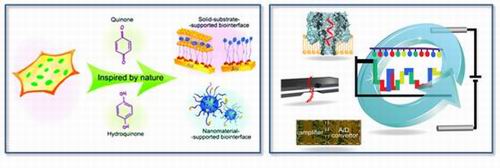Recently, Prof. Long Yi-Tao was invited to contribute two review papers entitled “Quinone/Hydroquinone-Functionalized Biointerfaces for Biological Applications from the Macro- to Nano-Scale” and “Nanopore-Based Sequencing and Detection of Nucleic Acids” for Chem. Soc. Rev. and Angew. Chim. Int. Ed., respectively.
Based on the achievements on biointerface fabrication and biosensing, Prof. Long Yi-Tao summarized the current methods used to functionalize Q/HQ on biointerfaces from the macro- to nano-scale in the review of “Quinone/Hydroquinone-Functionalized Biointerfaces for Biological Applications from the Macro- to Nano-Scale (Chem. Soc. Rev., 2013, DOI: 10.1039/C3CS60174A)”. Particularly, this review pointed that exciting applications will arise when Q/HQ-functionalized biointerface systems are coupled with biomimetic strategies.
Meanwhile, Prof. Long Yi-Tao ‘s group utilized an α-hemolysin (α-HL) protein channel as an ultra-sensitive sensor for single-molecule detection of biological weak interactions. In their review (Nanopore-Based Sequencing and Detection of Nucleic Acids(Angew. Chim. Int. Ed., 2013, DOI: 10.1002/anie.201303529)) , they summarized the latest progress in nanopore-based sequencing and detection of nucleic acids are summarized, and light is shed on a novel platform for nanopore-based detection.
These works are supported by the National Science Fund for Distinguished Young Scholars of China and the National Base Research 973 Program (Basic Research on Detection of Tumor-Specific Serum Marker by Molecular Sensors).

Left: Q/HQ-functionalized biomimetic biointerface; Right: Detection of individual nucleic acids by nanopore techniques.
Related links: http://pubs.rsc.org/en/content/articlelanding/2013/cs/c3cs60174a
http://onlinelibrary.wiley.com/doi/10.1002/anie.201303529/full




